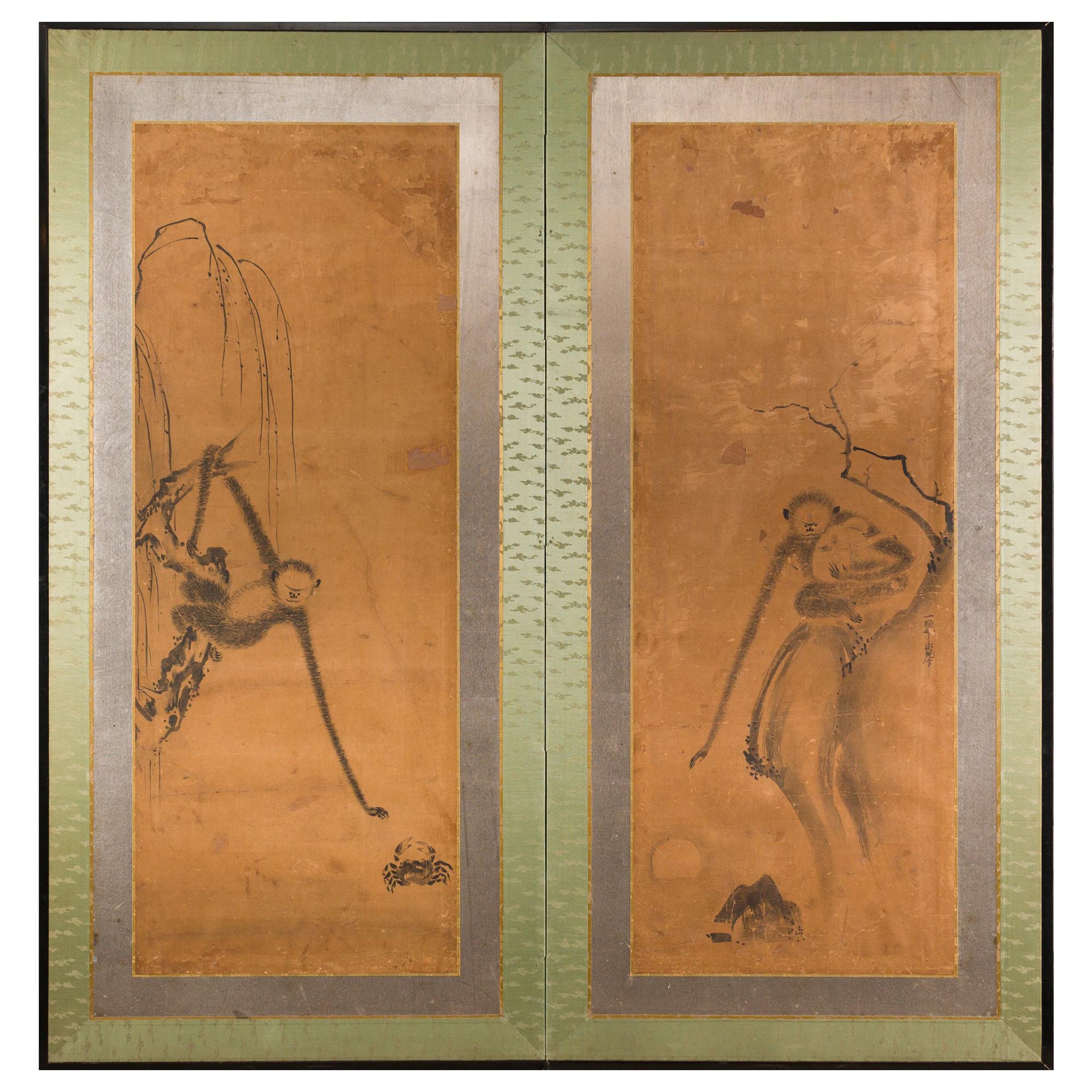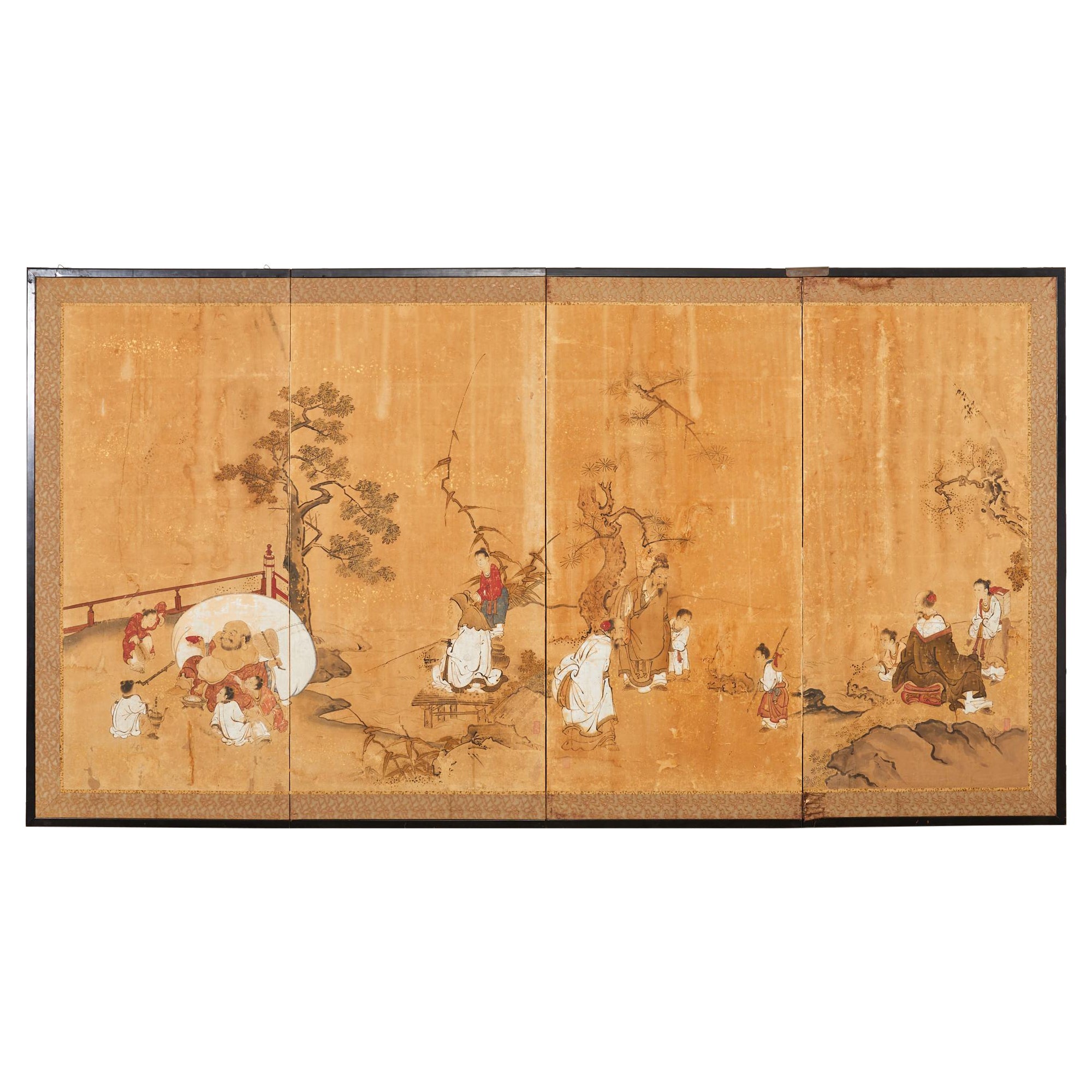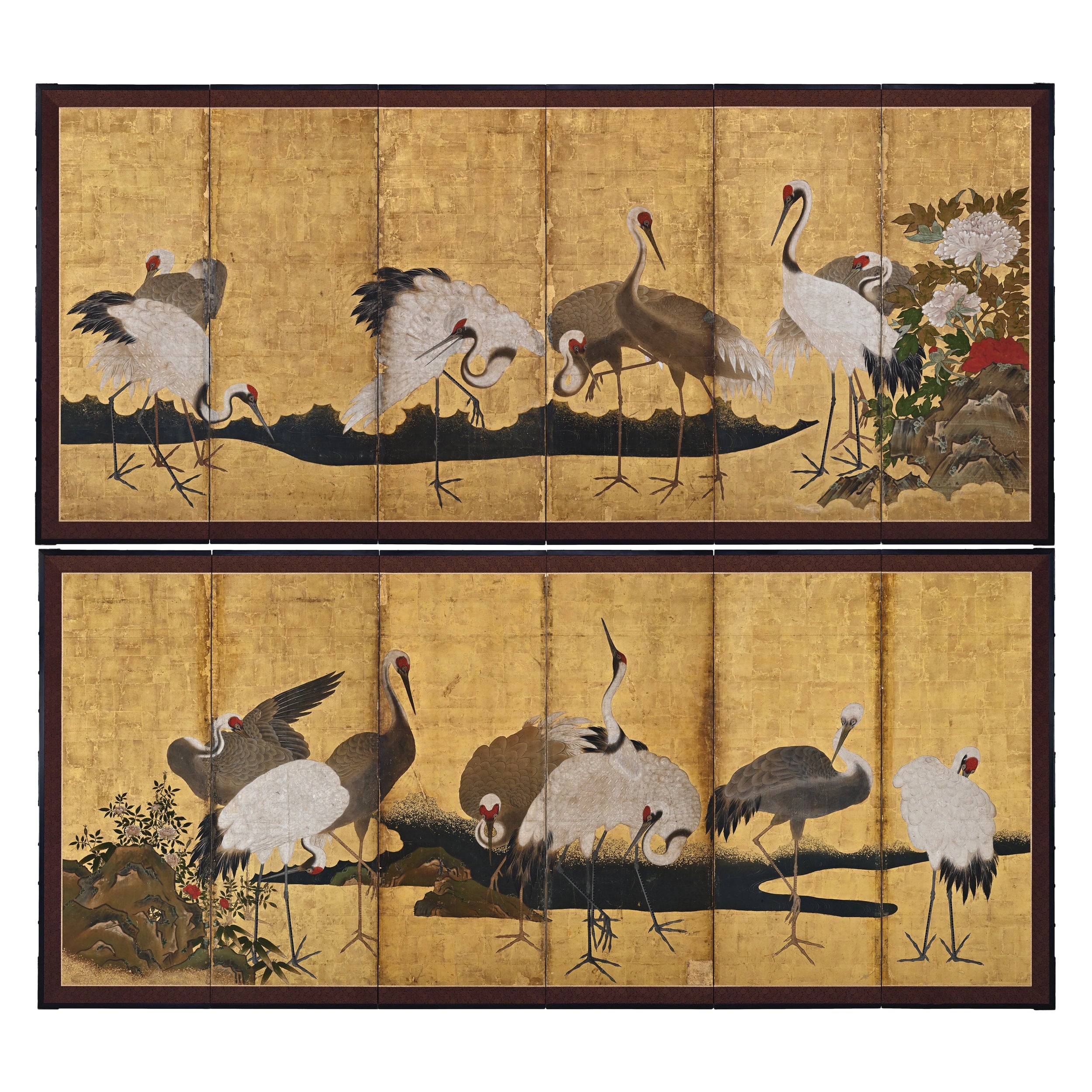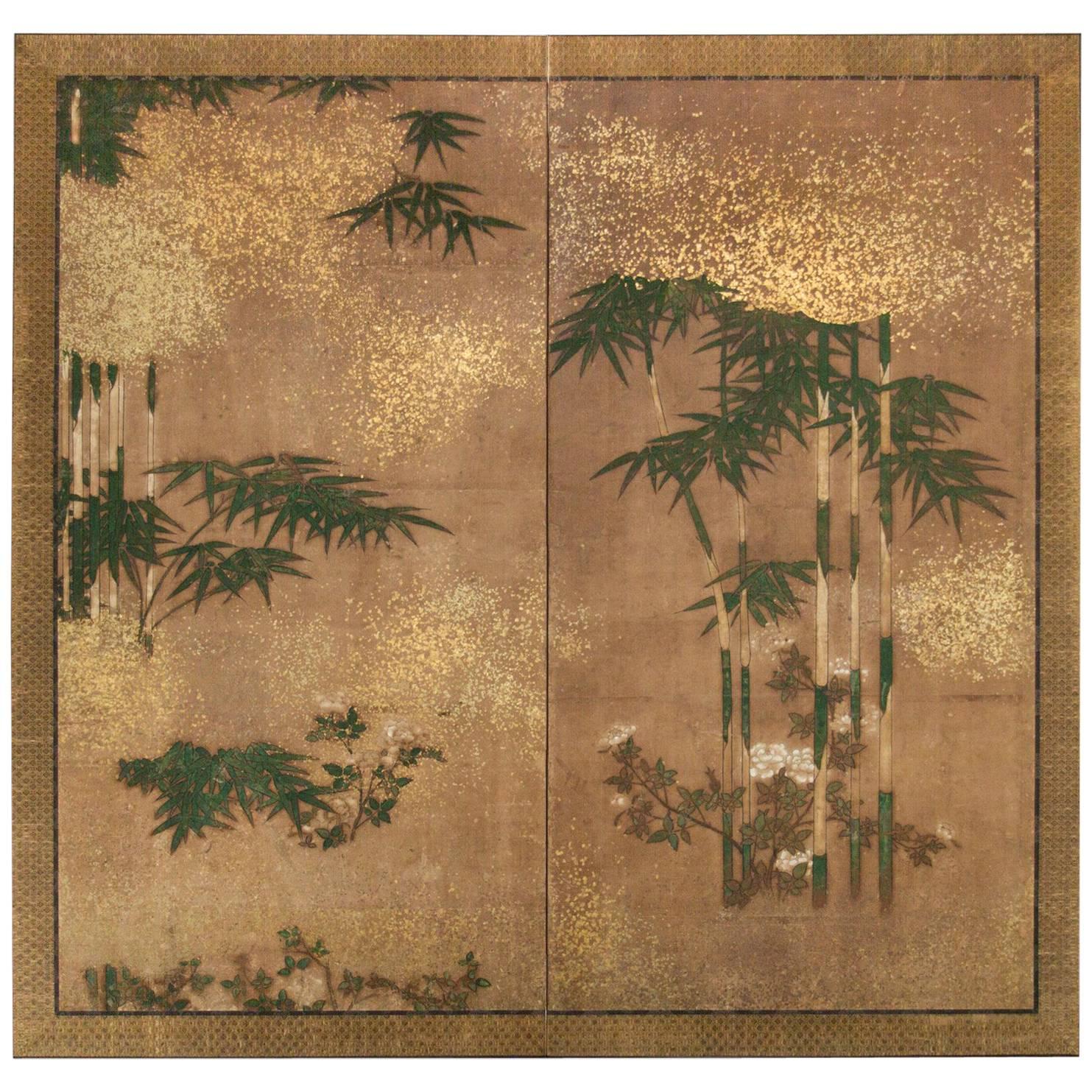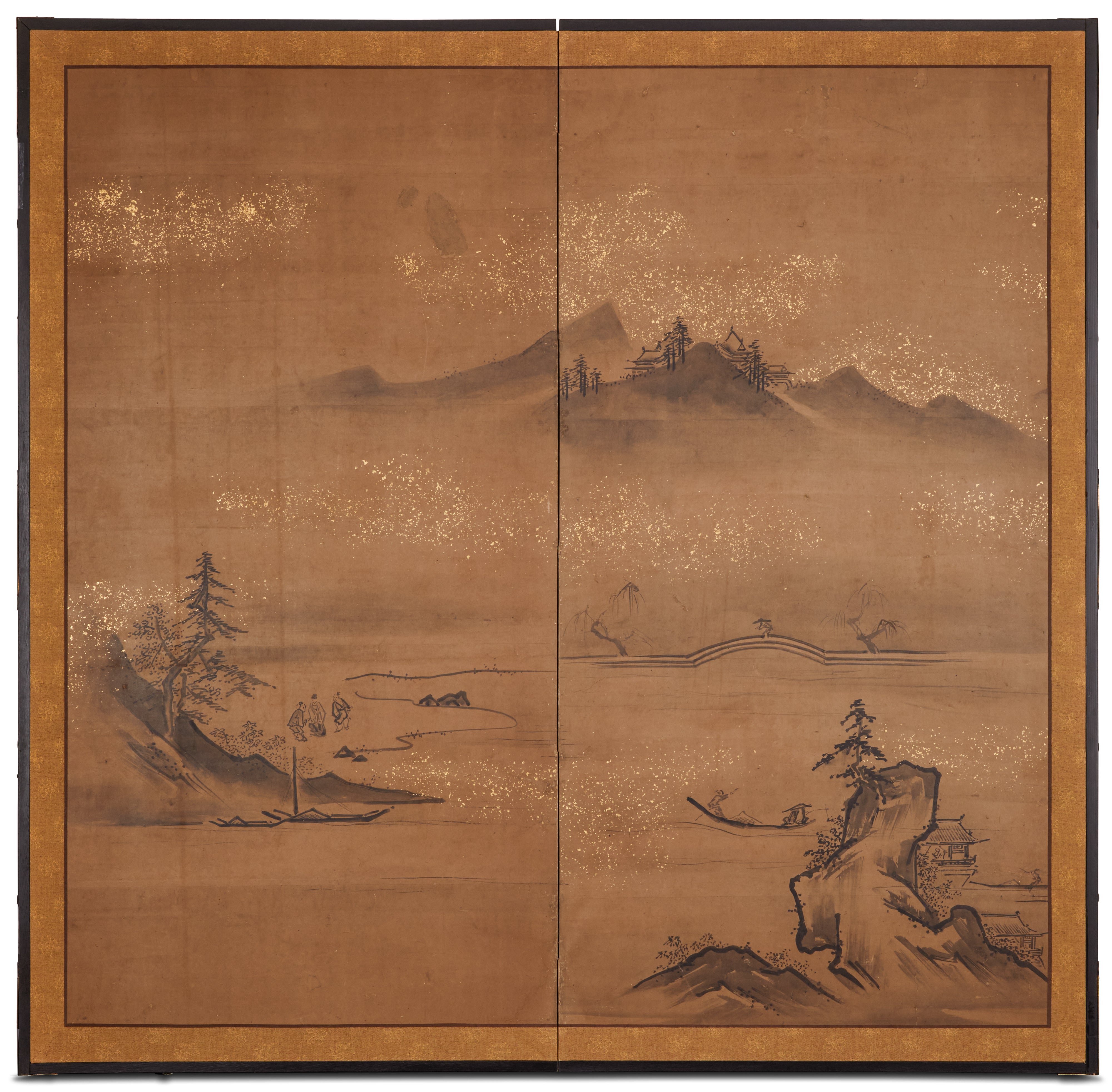Items Similar to Japanese 17th Century Two Panel Screen, Pine with Gold Dust
Want more images or videos?
Request additional images or videos from the seller
1 of 8
Japanese 17th Century Two Panel Screen, Pine with Gold Dust
About the Item
Beautiful 17th century painting of pine trees. Painting in good condition on 19th century mounting. Mineral pigments and gold dust on mulberry paper with nice old brocade. Can be mounted as 2 separate panels for an additional charge.
- Dimensions:Height: 68 in (172.72 cm)Width: 74.25 in (188.6 cm)Depth: 0.75 in (1.91 cm)
- Style:Edo (Of the Period)
- Materials and Techniques:
- Place of Origin:
- Period:
- Date of Manufacture:17th Century
- Condition:17th century painting on 19th century mounting. Painting in good condition.
- Seller Location:Hudson, NY
- Reference Number:
About the Seller
5.0
Recognized Seller
These prestigious sellers are industry leaders and represent the highest echelon for item quality and design.
Established in 1971
1stDibs seller since 2008
151 sales on 1stDibs
Typical response time: 11 hours
Associations
The Art and Antique Dealers League of AmericaAntiques Associations Members
- ShippingRetrieving quote...Ships From: Hudson, NY
- Return PolicyThis item cannot be returned.
More From This SellerView All
- 17th Century Japanese Two-Panel Screen, Gibbons of FolkloreLocated in Hudson, NYJapanese two-panel screen: Gibbons of Folklore, Edo period (17th century) Kano School painting of gibbons in Japanese fables. The left panel represents a Japanese fable of a monkey a...Category
Antique Late 17th Century Japanese Edo Paintings and Screens
MaterialsSilk, Wood, Paper
- Japanese Two Panel Screen: Bamboo Grove on Mulberry Paper with Gold DustLocated in Hudson, NYKano School painting of a bamboo grove with blooming flowers and gold dust mists. Painted in mineral pigments on mulberry paper with gold dust and a silk brocade border.Category
Antique Early 19th Century Japanese Edo Paintings and Screens
MaterialsGold
- Japanese Two Panel Screen, Ink Landscape on Paper with Gold DustLocated in Hudson, NYSesshu-style painting in ink on mulberry paper with gold dust accents and a silk brocade border.Category
Antique 19th Century Japanese Paintings and Screens
MaterialsGold
- Japanese Two Panel Screen: Pine on Heavy GoldLocated in Hudson, NYKano School painting in mineral pigments on mulberry paper with heavy gold leaf and a silk brocade border made of antique monk's robes.Category
Antique Late 19th Century Japanese Paintings and Screens
MaterialsGold Leaf
- Late 17th-Early 18th Century Japanese Six-Panel Screen, Battle at Uji BridgeLocated in Hudson, NYJapanese six-panel screen: Battle at Uji Bridge, the first battle at Uji was in 1180 and it marked the start of the Heike Wars. The Genji troops crossed the...Category
Antique Late 17th Century Japanese Edo Paintings and Screens
MaterialsGold Leaf
- Japanese Two Panel Screen, HollyhocksLocated in Hudson, NYEdo period (18th century) furosaki screen (tea screen), with seal of the artist: Jakyu. Korin School painting, employing Kenzan style of split image. (see "Morning Glories" Metropoli...Category
Antique 18th Century Japanese Edo Paintings and Screens
MaterialsWood, Silk, Paper
You May Also Like
- 17th Century Rinpa School Two-Panel Screen with KoiBy Rimpa SchoolLocated in Fukuoka, JP17th-18th Century Rinpa School Two-Panel Screen Period: 17th-18th century Size: 140 x 125 cm (55 x 49 inches) SKU: PTA43 This beautiful two-panel screen is a classic example of the...Category
Antique 17th Century Japanese Edo Paintings and Screens
MaterialsWood, Paper
- 17th Century Japanese Edo Four Panel Screen Hotei with Chinese SagesLocated in Rio Vista, CABeautifully weathered late 17th/early 18th century Japanese edo period four panel byobu screen depicting hotei (fat monk) in a treed landscape with Chinese sages engaged in leisurely...Category
Antique 17th Century Japanese Edo Paintings and Screens
MaterialsBrass
- 17th Century Japanese Screen Pair, CranesLocated in Kyoto, JPCranes Anonymous, Kano School. Edo period, second half of the 17th century. Pair of six-panel screens. Ink, pigment gofun and gold l...Category
Antique 1670s Japanese Edo Paintings and Screens
MaterialsGold Leaf
- 17th Century Japanese Screen Pair by Soga Nichokuan, Hawks on Pine & Plum TreesLocated in Kyoto, JPHawks on plum and pine Soga Nichokuan (active circa 1625-1660) Pair of six-fold screens. Ink, mineral pigments, gofun, gold and speckled gold leaf on paper. Upper seal: H...Category
Antique 1640s Japanese Edo Paintings and Screens
MaterialsWood, Paper
- Late 17th Century Japanese Screen. Puppy and Kittens on Gold Leaf.Located in Kyoto, JPAnonymous Late 17th century Puppy & Kittens A six-panel Japanese screen. Ink, color, gofun, gold-leaf and gold-fleck on paper. A medium sized late 17th century Japanese screen fe...Category
Antique Late 17th Century Japanese Edo Paintings and Screens
MaterialsGold Leaf
- 17th Century Japanese Screen Pair. Tiger & Dragon by Kaiho YusetsuLocated in Kyoto, JPKaiho Yusetsu (1598-1677) Tiger and Dragon Early Edo Period, Circa 1650 A Pair of Six-fold Japanese Screens. Ink and slight color on paper. Dimensions: Each screen: H. 171 cm x W. 380 cm (67.5’’ x 149.5’’) In this pair of early Edo period Japanese screens a group of tigers prowl in a bamboo grove whipped with fierce wind, while a dragon claws through clouds and mist. The dragon embodies elemental qualities - looming out of the mist, the coils of its body disappearing in the clouds. The dragon is calling for rain, symbolizing spring which is considered the fountain of life. On the other side, the tigers calls for the wind, symbolizing autumn which is considered the end of life. Tigers were familiar motifs within Japanese art from ancient times though the animals were imaginary to the people in the 17th century. While dragons and tigers are usually associated as sacred and ferocious, in this painting, both animals have rather amusing expressions. The tigers appear to glare at the dragon with cat-like eyes, and the look on the swirling dragon’s face appears almost affectionate - lending a playful flair to an otherwise magnificent theme. The tiger and dragon are cosmological symbols of the balancing forces in the world. Screens such as this were originally meant to express the fluctuating nature of the world. For Japanese in the early Edo period, they likely suggested the powers of the cosmos. In Japan the tiger and dragon motif was originally absorbed into the circles of Zen monasteries before spreading into the secular world. The theme especially appealed to the military classes with the Kano school, the official painters to the Shogun and the samurai, being the leading contributors. The painter of this pair of screens, Kaiho Yusetsu (1598-1677), was closely patronized by the third Shogun Tokugawa Iemitsu. In his later years he worked with Kano school artists...Category
Antique Mid-17th Century Japanese Edo Paintings and Screens
MaterialsSilk, Wood, Paper
Recently Viewed
View AllMore Ways To Browse
Gold Dust
17th Panel
17th Century Panel
17th Gold
17th Century Gold
19th Century Screens Asia
Screen Tree
Gold Japanese Panel
Screen With Trees
Gold Japanese Screens
Gold Screen Japan
Pines Japanese
Panel Screens In Gold
Japanese Gold Screen
19th Century Japanese Screen
Mounted Minerals
Gold Japanese Screen Panel
Japanese Screen Gold On Gold
